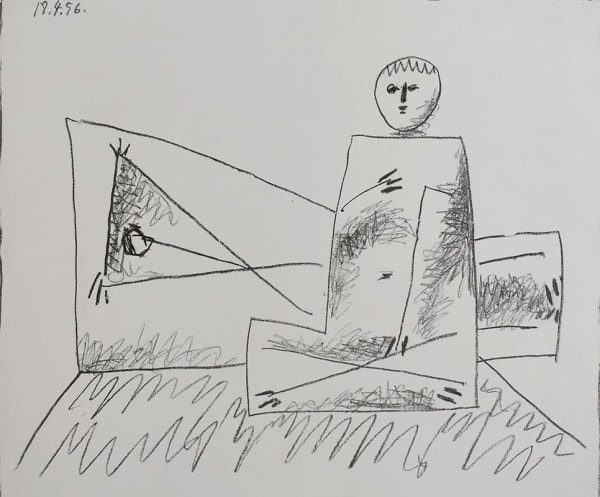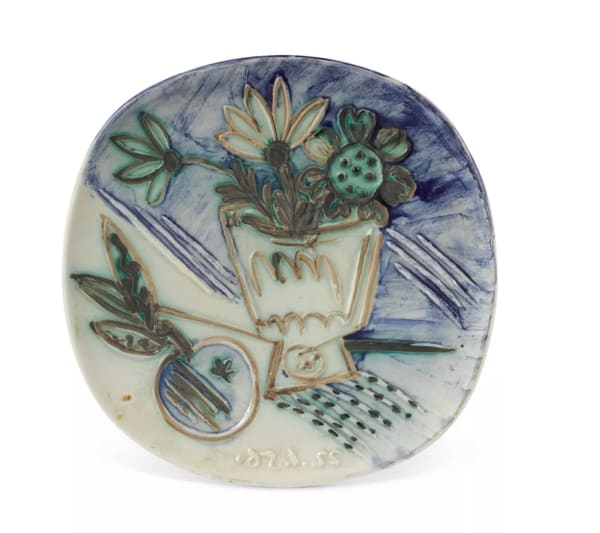
Pablo Picasso
Bloch 664; Mourlot 186; Kramer 60
49.8 x 65.1 cm
Pablo Picasso’s Paloma et Claude, 1950, a lithograph made using the experimental technique of fingerpainting with ink on lithographic transfer paper. Catalogued as Bloch 664; Mourlot 186; Kramer 60, it captures the intimacy of Picasso’s family life and his continual innovation in printmaking.
The lithograph presents two faces side by side—those of Picasso’s children, Paloma and Claude. The image is both tender and experimental, with one face emerging in light tones, softly delineated, while the other appears darker, more textured, and deeply shadowed. This juxtaposition creates a dialogue between innocence and introspection, presence and mystery.
The choice to place the faces in direct contrast heightens their individuality while suggesting the shared bond of siblings. The delicacy of line and the boldness of inky textures reflect Picasso’s ability to fuse spontaneity with psychological depth.
What sets Paloma et Claude apart is Picasso’s fingerpainting technique on lithographic transfer paper. Instead of relying solely on traditional tools, Picasso used his hands to manipulate ink, pressing, smudging, and shaping the medium directly. This method imbues the work with a raw immediacy, as if the artist’s touch is imprinted in the very essence of the image.
The lighter portrait on the left feels airy and almost ethereal, achieved through gentle strokes and wiped-back ink, while the right portrait carries weight and density, with rich textures created by pressing and dragging the medium. This direct, tactile approach demonstrates Picasso’s relentless experimentation and desire to push the boundaries of printmaking.
Paloma et Claude is not only a portrait of Picasso’s children but also a meditation on the act of creation itself. By using his fingers rather than conventional tools, Picasso collapses the distance between artist and subject—the work becomes a record of touch, intimacy, and presence.
The contrast between the two faces can be seen as symbolic: one reflecting openness and the bright promise of childhood, the other embodying depth, complexity, and shadow, perhaps a reminder of the duality inherent in all human experience.
Paloma et Claude (1950) is a lithograph by Pablo Picasso, created through fingerpainting with ink on lithographic transfer paper. Catalogued as Bloch 664; Mourlot 186; Kramer 60, the print portrays the faces of Picasso’s children in stark contrast—one light and ethereal, the other dark and richly textured. By abandoning traditional tools in favor of direct hand application, Picasso imbues the work with immediacy and intimacy, fusing familial tenderness with radical experimentation in printmaking.
For more information or to buy Paloma et Claude by Pablo Picasso, contact our galleries using the form below.-
 Pablo PicassoLe Corsage à Carreaux, 1949
Pablo PicassoLe Corsage à Carreaux, 1949 -
 Pablo PicassoGrand Maternite, 1963
Pablo PicassoGrand Maternite, 1963 -
 Pablo PicassoFrançoise Sur Fond Gris, 1950
Pablo PicassoFrançoise Sur Fond Gris, 1950 -
 Pablo PicassoReclining Man and Crouching Woman | Homme couché et femme accroupie, 1956
Pablo PicassoReclining Man and Crouching Woman | Homme couché et femme accroupie, 1956 -
 Pablo PicassoThe Little Artist (Draughtsman) | Le petit dessinateur, 1954
Pablo PicassoThe Little Artist (Draughtsman) | Le petit dessinateur, 1954 -
 Pablo PicassoTete De Femme Fond Noir, 1946
Pablo PicassoTete De Femme Fond Noir, 1946 -
 Pablo PicassoBuste de Femme au Corsage Blanc (Jacqueline de Profil), 1957
Pablo PicassoBuste de Femme au Corsage Blanc (Jacqueline de Profil), 1957 -
 Pablo PicassoBuste au fond étoilé (Bust with Star Background), 1949
Pablo PicassoBuste au fond étoilé (Bust with Star Background), 1949 -
 Pablo PicassoJeu De La Cape (Bloch 1015), 1961
Pablo PicassoJeu De La Cape (Bloch 1015), 1961 -
 Pablo PicassoJacqueline Profile to the Right, 1958
Pablo PicassoJacqueline Profile to the Right, 1958 -
 Pablo PicassoLes Demoiselles d'Avignon, 1953
Pablo PicassoLes Demoiselles d'Avignon, 1953 -
 Pablo PicassoJacqueline with Roses, 1956
Pablo PicassoJacqueline with Roses, 1956 -
 Pablo PicassoFemme à L'Italienne d'après le tableau de Victor Orsel (Bloch 740), 1953
Pablo PicassoFemme à L'Italienne d'après le tableau de Victor Orsel (Bloch 740), 1953 -
 Pablo PicassoGrand Nature Mort au Compotier, 1947
Pablo PicassoGrand Nature Mort au Compotier, 1947 -
 Pablo PicassoAfter The Embrace, 1901
Pablo PicassoAfter The Embrace, 1901 -
 Pablo PicassoProfil de Femme
Pablo PicassoProfil de Femme -
 Pablo PicassoProfil au fond noir, 1947
Pablo PicassoProfil au fond noir, 1947 -
 Pablo PicassoRonde de la Jeunesse, 1961
Pablo PicassoRonde de la Jeunesse, 1961 -
 Pablo PicassoFemme à la Robe
Pablo PicassoFemme à la Robe -
 Pablo PicassoBouquet à la pomme , 1956
Pablo PicassoBouquet à la pomme , 1956 -
 Pablo PicassoCorrida sur fond noir, 1953
Pablo PicassoCorrida sur fond noir, 1953 -
 Pablo PicassoBuste, 1957
Pablo PicassoBuste, 1957 -
 Pablo PicassoPortrait de Femme II, 1955
Pablo PicassoPortrait de Femme II, 1955 -
 Pablo PicassoTête de Jeune Fille – Portrait de Françoise, 1949
Pablo PicassoTête de Jeune Fille – Portrait de Françoise, 1949 -
 Pablo PicassoJeunesse, 1950
Pablo PicassoJeunesse, 1950
Join our mailing list
* denotes required fields
We will process the personal data you have supplied in accordance with our privacy policy (available on request). You can unsubscribe or change your preferences at any time by clicking the link in our emails.
This website uses cookies
This site uses cookies to help make it more useful to you. Find out more about cookies.
























